Click on images to enlarge

habit (Photo: Trevor James)
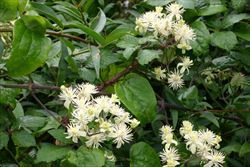
leaves and flower clusters (Photo: Trevor James)
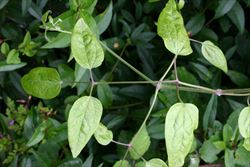
compound leaf with five leaflets (Photo: Trevor James)
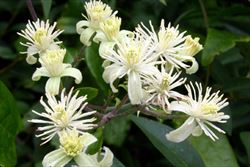
close-up of flowers (Photo: Trevor James)
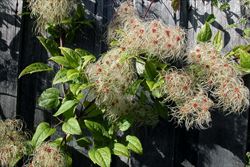
immature fruit (Photo: Trevor James)
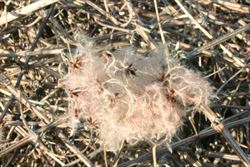
mature fruit (Photo: Trevor James)
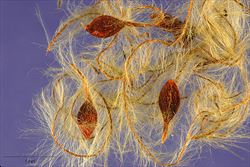
close-up of seeds (Photo: Jose Hernandez at USDA PLANTS Database)

the very similar mountain clematis (Clematis montana), which has recently become naturalised in the Blue Mountains (Photo: Sheldon Navie)
Scientific Name
Clematis vitalba L.
Synonyms
Clematis vitalba L. var. vitalba
Family
Ranunculaceae
Common Names
boys-bacca, clematis, evergreen clematis, graybeard, hedge feathers, mile-a-minute, old man's beard, Tom-bacca, traveler's joy, whiffy cane
Origin
Native to northern Africa (i.e. northern Algeria), Europe (i.e. France, Portugal, Spain, UK, Austria, Belgium, Czechoslovakia, Germany, Hungary, the Netherlands, Poland, Switzerland, southern Russia, Ukraine, Albania, Bulgaria, Greece, Italy, Macedonia, Romania and Yugoslavia) and western Asia (i.e. Afghanistan, Cyprus, northern Iran, Lebanon, Syria, Turkey, Armenia, Azerbaijan and Georgia).
Naturalised Distribution
Naturalised in many parts of south-eastern Australia (i.e. southern Victoria, south-eastern South Australia and Tasmania).
Also naturalised overseas in New Zealand, Canada and western USA (i.e. Washington, Oregon and California).
Notes
Old man's beard (Clematis vitalba) is regarded as an environmental weed in Victoria and Tasmania, and as a potential environmental weed or "sleeper weed" in other parts of southern Australia. It generally grows along waterways (i.e. in riparian areas), in forest margins, urban areas and remnant bushlands, and is seen as a threat to the coastal vegetation and grassy woodlands of temperate Australia.
In New Zealand it initially colonises forest edges or gaps, where there is plenty of light, and gradually moves towards the centre of forests. Old man's beard (Clematis vitalba) often dominates the canopy layer and restricts light penetration to lower levels, thereby suppressing all vegetation beneath it. Eventually the most heavily infested trees fall over under the plant's weight, and in this way it can destroy native vegetation. When this loss of the canopy occurs there is an increased risk for an influx of other exotic weeds into the gaps that are created. For this reason old man's beard (Clematis vitalba) is a major management problem in national parks and reserves in New Zealand, and it has been listed in the "top ten weeds of importance" in this country. It is also listed in the Global Invasive Species Database.

